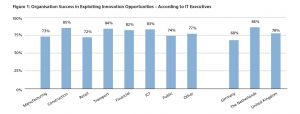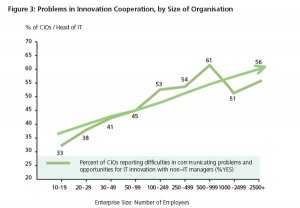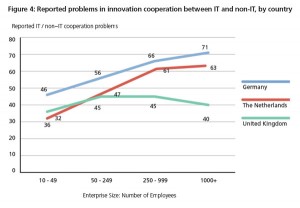By Joe Peppard, Simon Robinson and Tobias Hüsing
If your company doesn’t want to miss out on the new opportunities IT offers for business innovation, you need people at C-level with a challenging combination of competencies: they have to be digitally literate, business aware and be able to engage in conversations together about digital and the possibilities for transformation. New data from a European survey shows that the bigger enterprises are finding it particularly difficult to get this “e-leadership” mix in place. Below, Joe Peppard, Simon Robinson and Tobias Hüsing offer advice to these CIOs to promote the necessary engagement and dialogue to fully embrace digitisation.
New technology innovations are bringing enormous potiential for business innovation across all enterprises: massive flows of data from which critical knowledge and insights can be prised; social media offering new market presence; mobile devices giving direct access to customers 24/7; apps redefining business models, etc. The modern CIO must understand these developments, actively scouting for new IT innovations that can potentially be harnessed for operational and strategic impact.
However, this is usually not enough, business leaders outside of the IT organisation are often wary of what they see as technology being “pushed” on them. Any conversation around proposals for digital innovation must be fully aligned with business drivers, perhaps suggesting new business models to increase revenue or new ways of doing business. Other things that could be suggested are new competitive products and process innovation that contributes to operational excellence or ideas to improve the customer experience. This requires e-leadership: a combination of business assessment with real insight into the capabilities and possibilities of technology. But even this is not always enough, the vision for the innovation has to be communicated, trust engendered and fears of downside allayed.
[ms-protect-content id=”9932″]
The European Survey
To find out how CIOs experience the challenge of innovating with IT today, 900 heads of IT were interviewed. These came from all sectors, including public services, and explored the successes and failures of IT-enabled innovation.
In designing our survey, we set out from the idea that innovation is likely to succeed where the CIO has a clear vision of the opportunity for innovation, communicates this effectively to colleagues, ensures business value is properly assessed, and helps guide the transformation process. This e-leadership may fail where opportunities for communication with executive colleagues are missing or – for whatever reason – colleagues fail to grasp the significance of the vision. It was also of interest to us to know if innovation ideas are flowing in from business executives, showing that this understanding of options for exploiting new ICT is not limited to the CIO and staff. Organisations without the capability to generate and assess innovation ideas themselves must resort to responding to those from vendors and other third parties, despite the fact that outsiders will typically not have deep knowledge of their business.
Accordingly, we first sought to find out how much IT-based innovation is acutally going on in an enterprise, to then look at where in the organisation ideas are coming from and finally to look at leadership problems in guiding any investments to success.
Capitalising on Innovation Ideas
Nearly three quarters of the enterprises surveyed reported having initiated or completed at least one innovation project within the previous year – less than 20% were unable to report any innovation over the last 5 years.
However, nearly a quarter of CIOs report that opportunities for IT-based innovation are not being addressed in a timely fashion and with appropriate resources, meaning there is an acute risk of critical loss of competitive advantage. Deficits in grasping innovation opportunities are almost equally prevalent even in the largest enterprises, according to their CIOs (see Figure 1). Empirically, the perceived gap tends to be just a little larger in smaller organisations than in bigger ones; and larger in manufacturing, retail and wholesale trade and public services than in ICT, financial services, construction and transport and logistics; and larger across organisations in Germany.
According to their CIO colleagues interviewed, only about half of organisations today have business executives who have a level of understanding of IT sufficient to identify innovation opportunities shaped by IT in their market area (see Figure 2). This is true across all size categories – there is just as large a proportion of the largest organisations reporting this problem as among small organisations. In industries that excel in IT-based innovation – ICT, financial, retail and wholesale sectors – more CIOs acknowledge that colleagues outside IT are seeding innovation opportunities.
Across all enterprises the source of innovation project ideas is quite balanced in origin. 62% of the enterprises surveyed report ideas had originated from IT department staff, and 68% of the reporting ideas had also come from staff in business units. Vendor or other external impetus is also quite prevalent: 23% of organisations report ideas flowing in from external sources.
When we look at individual enterprises, we find less than half reporting that they respond successfully to IT-based innovation opportunities and that the mandate to innovate with digital technologies is accepted by all in the C-suite. In these organisations, the executive team grasp opportunities in a timely way and all CXOs are contributing to conversations concerning digital. This is in contrast to the 16% of enterprises, mainly small organisations, where opportunities are not being addressed adequately and business executives are seen as lacking IT savvy. In 35% of enterprises, digital opportunities are being identified only from within the IT organisation – other executives are seen as lacking an understanding of contemporary IT capabilities to be able to do this. For a small number of respondents (7%), despite reporting non-IT executives as being ICT savvy, their organisations appear to be failing to grasp opportunities for IT-enabled innovation, due perhaps to a lack of the necessary resources.
Our analysis indicates strongly that the entire executive team must be digitally savvy and engage in the necessary dialogue to deliver sustained competitiveness from IT innovation opportunities. To drive such dialogue, e-Leaders need to be able to envision possibilities for innovation, and to assess its likely impact for the organisation, they also need to communicate this vision to colleagues, particularly to those accountable for the performance of the business areas to be transformed.
Leading to Innovation Success
To further expose how e-leadership can impact an organisation in leveraging digital innovation opportunities, respondent IT executives were asked to report on any difficulties in communicating problems and opportunities for IT innovation with colleagues outside of the IT organisation. Overall, their responses show that a failure of innovation communication is a significant issue for half of those surveyed.
Figure 3 highlights that the smallest organisations are least likely to experience innovation-related communication problems. When an organisation comprises less than 30 employees in total, the frequency of interaction across specialisms will be high, facilitating mutual understanding across disciplines even when, initially, different languages (jargon) are spoken.
In larger organisations, problems in innovation-related cooperation become more prevalent. The proportion of organisations with between 500 and 1000 employees reporting problems in innovation cooperation is nearly twice as high as that among the smallest organisations.
At first sight we might expect that the underlying trend is linear – see the arrow in Figure 3 (next page). However, there is a break visible in this trend which is unlikely to be a statistical anomaly: data from the largest organisations shows the proportion that reported problems in innovation-related communication dropping compared to smaller organisations. This divergence from a pure size trend poses the question as to how the largest organisations are coping better. Are they recruiting or educating better skill sets? Have they found a solution to e-leadership issues?
The aggregate data suggest a non-linear relationship, that solutions to communications problems start being found as enterprises grow beyond the 1000 employee mark. We speculate that recruiting or training to ensure executives are equipped with the necessary cross-disciplinary competence and communication skills could be the solution that is being found. This picture is compatible with the view that e-leadership skills are being fostered only in the largest enterprises today, and are particularly missing in organisations in the mid-range (100-1000 employee size category).
A breakdown of the data by country (see Figure 4) reveals surprising differences, perhaps signalling potential for improvement for some of the largest enterprises in Europe: Germany shows an unbroken upward trend, close to linear, whereas the UK curve differs significantly. If we are right in seeing e-leadership skills as a key issue, German organisations appear not to deploy e-leadership to combat the structural cooperation difficulties which growth brings. Given the legendary innovation success of the German Mittelstand, are there opportunities here to improve the innovation rate in the largest German corporations?
UK enterprises diverge particularly strongly from the pure size trend. This suggests that in the UK effective management action is taken by the larger organisations to source e-leadership skills. Other research we have done shows that programmes to provide these skills are more prevalent in the UK, but also in the Netherlands. The Netherlands shows an intermediate path between its two large neighbours. This is despite strong development of e-leadership skill provision in that country. This poses the question as to why these efforts are not as visibly effective in mid-sized organisations as they have been in the UK.
Achieving collaborative and productive working relationships between the CIO and the leadership team is essential to harness digital opportunities and ultimately to optimise value from investments in digital. In conversations a shared understanding must emerge through co-learning and sense-making.
What can a CIO do?
Where e-leadership is lacking CIOs have a choice. They can do nothing and accept the current situation, which indicates a lack of any real business leadership capability, or they can look to change a situation that is clearly impairing their organisation in leveraging digital opportunities. From our research we developed the following suggestions:
Act like a business leader. Remember that a CIO is first and foremost a business leader, albeit with a special responsibility for IT. Develop a view on what is happening in the business and its environment, engage in discussions on strategy and innovation, be open to some political manoeuvring – politics is part and parcel of organisational life and can be a way to finding the win-win situations.
Speak the language of the business. It might seem somewhat contradictory, but conversations in the C-suite about IT should never be about technology! The CIO who begins talking about technology risks confirming the stereotype of not being close to the business and losing their listeners. Avoid your jargon and talk business impacts: be clear about contributions to growth, margins and cost reduction.
Get out of the office. In order to get out there and find, test and present the best applications that meet business requirements, the CIO is going to have to understand the business requirements and priorities first. Engage with users, managers, executives, even go on a few sales calls, or listen in on conversations about supplier quality. Be and be seen as an agent of change, and be ready to show why resources are needed and change essential.
tion takes.
Use appropriate metrics to raise awareness of the value of IT. By making a shift in the way that CIOs measure IT value and impact, they have a common language to begin this new dialogue with their business partners.
Coach the leadership team on the opportunities and treats of IT. CIOs should spearhead the effort to educate, or better coach, the leadership team on digital issues. This can include briefings, frequent updates about IT initiatives, and the use of new IT tools. Some CIOs write regular blogs detailing how IT might be used by the business.
Start chasing innovation. It’s no longer good enough to just be there enabling innovative ideas; what’s imperative is working together side-by-side with C-suite colleagues to co-create value as the business digitises. Be proactive. One CIO uses the term “manufactured serendipity” to refer to the orchestrated series of events, presentations and workshops he initiates in order to spark ideas from within the executive ranks. Another has established an innovation unit to actively seek out technologies that can impact the more than 100 businesses that make up the group.
Recognise that shadow IT may not necessarily be a bad thing. In some organisations, so called shadow or “rogue” IT has emerged in response to the perceived inability of IT to deliver. Instead of seeing this as a risk or threat, take it as a sign of healthy innovation and a valuable opportunity for IT to work more closely with business partners to develop new capabilities.
Don’t be the Department of No. In some companies, the IT organisation has a reputation for saying no to everything. Get involved in initiatives when they are still the germ of an idea, don’t wait to block a fully-tested app in use. Communicate concerns early, shape the direction of conversations away from confrontation and be open to cooperation even with lay people.
The CIO who takes these messages to heart is likely to dramatically change the climate of communication with their business colleagues, catapulting the organisation towards the most promising innovations in IT.
About the Authors
 Joe Peppard is Professor of Management at the European School of Management and Technology in Berlin, Germany and an Adjunct Professor at the University of South Australia. He also sits on the Board of Directors of a number of technology companies. The focus of his research, teaching and consulting is in the broad areas of IT leadership and digital strategy, innovation and transformation. Through his research he seeks to challenge dominant orthodoxies as he believes that these are contributing significantly to the problems that organisations have in leveraging information technologies, both operationally and strategically, and ultimately in optimising the value delivered to the business. His books the Strategic Management of Information Systems: Building Your Digital Strategy (with J. Ward) and Digital Leadership for Boards and C-Suites (with J. Thorp) will appear later in 2015.
Joe Peppard is Professor of Management at the European School of Management and Technology in Berlin, Germany and an Adjunct Professor at the University of South Australia. He also sits on the Board of Directors of a number of technology companies. The focus of his research, teaching and consulting is in the broad areas of IT leadership and digital strategy, innovation and transformation. Through his research he seeks to challenge dominant orthodoxies as he believes that these are contributing significantly to the problems that organisations have in leveraging information technologies, both operationally and strategically, and ultimately in optimising the value delivered to the business. His books the Strategic Management of Information Systems: Building Your Digital Strategy (with J. Ward) and Digital Leadership for Boards and C-Suites (with J. Thorp) will appear later in 2015.
 Simon Robinson, MA (Cantab) is director of empirica Communication and Technology Research, heading consultancy and research teams at Empirica, evaluating innovations in the use of information and communication technology across the economy. Simon has consulted for the European Commission on topics from e-infrastructure to consumer issues in the information society. He currently coordinates a consortium of business schools generating guidelines for executive education
Simon Robinson, MA (Cantab) is director of empirica Communication and Technology Research, heading consultancy and research teams at Empirica, evaluating innovations in the use of information and communication technology across the economy. Simon has consulted for the European Commission on topics from e-infrastructure to consumer issues in the information society. He currently coordinates a consortium of business schools generating guidelines for executive education
on e-leadership.
 Tobias Hüsing (Dipl.-Volkswirt) is Senior Research Consultant at Empirica. He specialises in analysing and consulting on topics around ICT, competences and the labour market, including e-leadership and e-skills, as well as innovation and knowledge transfer policies. Tobias has worked extensively for the European Commission on e-skills supply and demand analysis and forecasting.
Tobias Hüsing (Dipl.-Volkswirt) is Senior Research Consultant at Empirica. He specialises in analysing and consulting on topics around ICT, competences and the labour market, including e-leadership and e-skills, as well as innovation and knowledge transfer policies. Tobias has worked extensively for the European Commission on e-skills supply and demand analysis and forecasting.
[/ms-protect-content]













